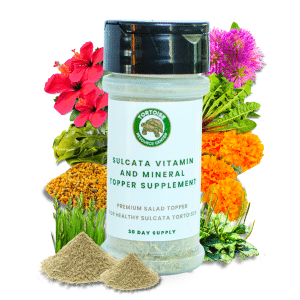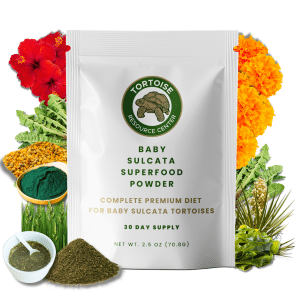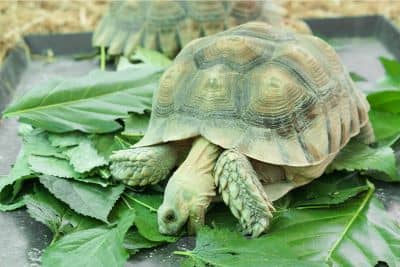Tortoises inhabit a variety of environments all around the world, ranging from arid deserts to lush forests, but central to their survival is one key factor: hydration.
Water is crucial for numerous physiological functions that directly impact the overall health and well-being of tortoises. In this article I cover how tortoises obtain their moisture and explore why hydration is paramount for these animals.
Water and Tortoise Physiology
Water plays a vital role in tortoise health and physiology for a number of reasons, as follows:
- Supporting enzyme function and biochemical reactions within cells.
- Aids the transportation of nutrients and waste products in and out of cells, ensuring proper cellular function and health.
- Enables the production and circulation of white blood cells needed to fight infections as part of the immune system.
- Aids the filtration and excretion of waste products from the bloodstream to support kidney function and prevent the formation of kidney and bladder stones.
- Hydration is imperative for the health and development of eggs in females and sperm in males.
- Helps in the digestion of food, allowing for the breakdown and absorption of nutrients and preventing constipation by keeping the digestive tract lubricated.
- Water is vital for thermoregulation as it helps tortoises maintain their body temperature through evaporative cooling.
- Sufficient hydration supports the overall health and well-being of tortoises.
Staying Hydrated
Due to the importance of hydration in tortoises, they have adapted numerous ways to stay hydrated in the wild, this includes:
- When available, tortoises will drink directly from a variety of natural water sources.
- Tortoises get a significant portion of their hydration from their herbivorous diet of succulent foods ranging from leafy vegetation to fruits to vegetables.
- The Namaqua speckled padloper tortoise (native to the arid regions of Namibia and South Africa) has evolved to collect water in the grooves on their shell and channel it directly into their mouth.
- Water can be absorbed directly through the skin and shell.
- The main way tortoises get their moisture is by absorbing it through their cloaca, a single opening located underneath the tortoise’s tail and acts as an elimination chamber for digestive, excretory and reproductive products.
In their natural habitats, there are three primary water sources from which tortoises rely on for hydration.
Firstly, rain is a primary water source for many tortoises. They instinctively know to drink after it collects on the ground or in depressions, forming temporary puddles and pools.
Next, they will naturally drink from other bodies of water that are more permanent such as springs, lakes and creeks.
Finally, some water sources are dependent on the time of day or year. For example, early mornings bring droplets of dew, whereas monsoon and vernal pools are seasonal events.

Providing Water for Pet Tortoises
Pet tortoises are no different to those in the wild, they need water to support their physical and mental health, well-being and longevity. This is one of the areas where good husbandry skills are of vital importance, especially for tortoises kept indoors or kept in climates with little or no rainfall.
Water Dishes and Bowls
Captive tortoises require constant access to clean, fresh water to avoid dehydration. I recommend choosing a dish that is suitable for both drinking and soaking.
Firstly, the dish should be large enough for your tortoise to fit in. The dish also needs to be shallow enough to prevent drowning but deep enough for your tortoise to submerge part of its body.
Typically, the water depth should not exceed the height of the tortoise’s plastron. A dish with gently sloping sides makes it easier for tortoises to enter and exit.
I suggest choosing a dish that is durable, easy to clean and mimics natural water sources.
The dish will need to be cleaned daily and refreshed with clean water to remove any bacteria or microorganisms that can affect the health of your tortoise. If tap water
Bathing and Soaking
Bathing and soaking are essential for keeping your tortoise well-hydrated. Bathing allows tortoises to absorb water through their skin, shell and cloaca to ensure adequate hydration, which supports essential bodily functions including food digestion, water excretion, thermoregulation and production of white blood cells (as detailed above).
Typically, bathing once or twice a week is sufficient, although young or sick tortoises may require daily baths.
You should use clean, lukewarm water that’s around 85oF to 90oF. You should soak your tortoise for around 20 minutes to allow for adequate absorption. After bathing, gently pat your tortoise with a towel and move them to a safe and warm location where they can dry off.
Bathing is especially important before and after hibernation. Before hibernation bathing helps them absorb water through their skin and cloaca, preventing dehydration during the long period of dormancy when they won’t be drinking water.
Additionally, bathing helps remove any dirt, feces, or parasites from their skin and shell and a clean tortoise is less likely to develop infections during hibernation.
Bathing also encourages tortoises to empty their bladder. Entering hibernation with a full bladder can lead to the build-up of toxic substances in their body, which can be harmful during the hibernation period.
After hibernation, tortoises can be dehydrated so bathing helps them quickly re-hydrate by absorbing water through their skin and cloaca.
A warm bath can help stimulate a tortoise’s appetite after hibernation. The warmth and hydration can encourage them to start eating again, which is essential for regaining strength and health.
Finally, as with pre-hibernation bathing, it can help tortoises pass any built-up waste or urates, which is important for their health after a long period of inactivity.
Misting and Humidity
In addition to bathing and drinking, humidity levels also play a vital role in keeping your tortoise hydrated.
Wild tortoises that live in arid environments often dig burrows to escape the heat and conserve moisture. These burrows provide a cooler, more humid micro-environment that helps reduce water loss through evaporation. Depending on their natural habitat, different species have different humidity requirements and you can find out about the specific humidity requirements of your tortoise species by checking out my care guides.
Once you understand the precise humidity requirements for your species, it’s important that you install a hydrometer to monitor humidity levels.
You can increase humidity levels in your tortoise’s enclosure in a number of ways. Firstly, select an enclosure substrate that retains moisture well, such as sphagnum moss. Live plants will help to naturally increase humidity levels as they release moisture through transpiration.
However, I find the most common and effective way to increase humidity levels is through misting. This can be achieved by using a humidifier or simply spraying your tortoise’s enclosure with water.
I recommend misting in the morning so that any residual moisture can be absorbed throughout the day when temperatures are warmer. Misting at night can lead to dampness in the enclosure that can ultimately cause respiratory issues and even shell rot.
Are You Starving Your Tortoise?
Save 10% on premium tortoise food and supplements from Tortoise Resource Center on Amazon now using code BUYNOWGET10

Sulcata Vitamin & Mineral Topper Supplement
30-Day Supply | 2 oz (56 g)
$24.99

Baby Sulcata Tortoise Superfood Powder
30-Day Supply | 2.5 oz (70.8 g) Bag
$24.99
Tap Water Safety Considerations
The safety of tap water will depend on the quality of the tap water in your region. As a general rule of thumb, if it is safe for human consumption, it will be safe for your tortoise.
In some regions, tap water can contain chemicals such as chlorine and chloramines, as well as heavy metals, which can be harmful to tortoises over time, so it’s worth considering the following and getting your tap water tested if you are in any doubt:
- Chlorine and Chloramines: Some water supplies contain chlorine or chloramines for disinfectant purposes. These chemicals can irritate a tortoise’s eyes and skin and can be harmful if ingested over time.
- Heavy Metals: Tap water may contain trace amounts of heavy metals like lead and copper, which can be toxic to tortoises.
- Hardness: The mineral content of tap water (its hardness) can also vary, and high levels of certain minerals might not be ideal for your pet tortoise.
It’s worth checking with your local veterinarian to understand how the local tap water may affect the health of your tortoise and also consider the following:
- De-chlorination: Use a water conditioner that neutralizes chlorine and chloramines. These products are commonly available at pet stores.
- Filtration: Use a water filter that removes heavy metals and other contaminants. Alternatively, you can let tap water sit out for 24 hours to allow chlorine to dissipate naturally.
- Bottled or Filtered Water: If tap water quality is poor, consider using bottled spring water or filtered water.
Monitoring Hydration
Monitoring the hydration status of your tortoise is crucial for maintaining its health and well-being. A hydrated tortoise will exhibit normal activities such as exploring, eating and passing healthy-looking poop regularly. Their skin will be more elastic in appearance, and their shell will be smooth and flake-free.
Common signs of dehydration in tortoises to look out for include:
- Weight loss
- Sunken or leaky eyes
- Dry, flaky and wrinkled skin
- Infrequent urination and urine that is thick
- Dry or unhealthy looking poop
- Loss of appetite
- Lethargy
- Thick mucus around the mouth
Addressing Dehydration
Dehydration occurs as a result of your tortoise not absorbing and ingesting enough moisture. If you suspect your tortoise is suffering from dehydration, there are steps you can take to re-hydrate it and prevent future cases.
Immediately place your tortoise in a bath to encourage them to drink and allow them to absorb moisture.
You should also encourage hydration through their diet by offering hydrating foods or soaking dry pellets in water. Moreover, you should adjust their habitat conditions to increase the humidity levels.
If symptoms persist, it’s a good idea to take your tortoise to a veterinarian. They can perform an examination to check your tortoise’s health, as well as offer advice for preventing future dehydration issues.
Citations
UCDavis – Water and soaking for Desert Tortoises
US Fish and Wildlife Service – Proactive Hydration and Water Uptake for Tortoises


